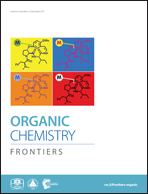Comparative investigation of the reactivities between catalysts [Cp*RhCl2]2 and [Cp*IrCl2]2 in the oxidative annulation of isoquinolones with alkynes: a combined experimental and computational study†
Abstract
The mechanisms and reactivities of the [Cp*RhCl2]2 and [Cp*IrCl2]2 catalyzed oxidative annulation reaction of isoquinolones with alkynes have been investigated by combined experimental and computational studies. The results have disclosed that the low reactivity of [Cp*IrCl2]2 is attributed to the electron-richness and low electronegativity of Ir(III). These factors make Ir(III) difficult to reduce to Ir(I) and thus lead to a high activation energy of the reductive elimination step. The electronic and steric effects of alkyne substituents on the reactivities have been investigated. Small-sized and strong electron-donating substituents on alkynes should enhance the reactivity of the reaction for both catalysts by not only avoiding the steric repulsion between substrates but also facilitating the reductive elimination. The rate-determining steps for reactions involving [Cp*RhCl2]2 and [Cp*IrCl2]2 are alkyne insertion and reductive elimination, respectively. When an alkyne bearing a small-sized and strong electron-donating substituent NMe2 is employed as a substrate, C–H activation becomes rate determining for both catalysts.
![Graphical abstract: Comparative investigation of the reactivities between catalysts [Cp*RhCl2]2 and [Cp*IrCl2]2 in the oxidative annulation of isoquinolones with alkynes: a combined experimental and computational study](/en/Image/Get?imageInfo.ImageType=GA&imageInfo.ImageIdentifier.ManuscriptID=C7QO00586E&imageInfo.ImageIdentifier.Year=2017)
- This article is part of the themed collection: Organic Chemistry Frontiers HOT articles for 2017


 Please wait while we load your content...
Please wait while we load your content...